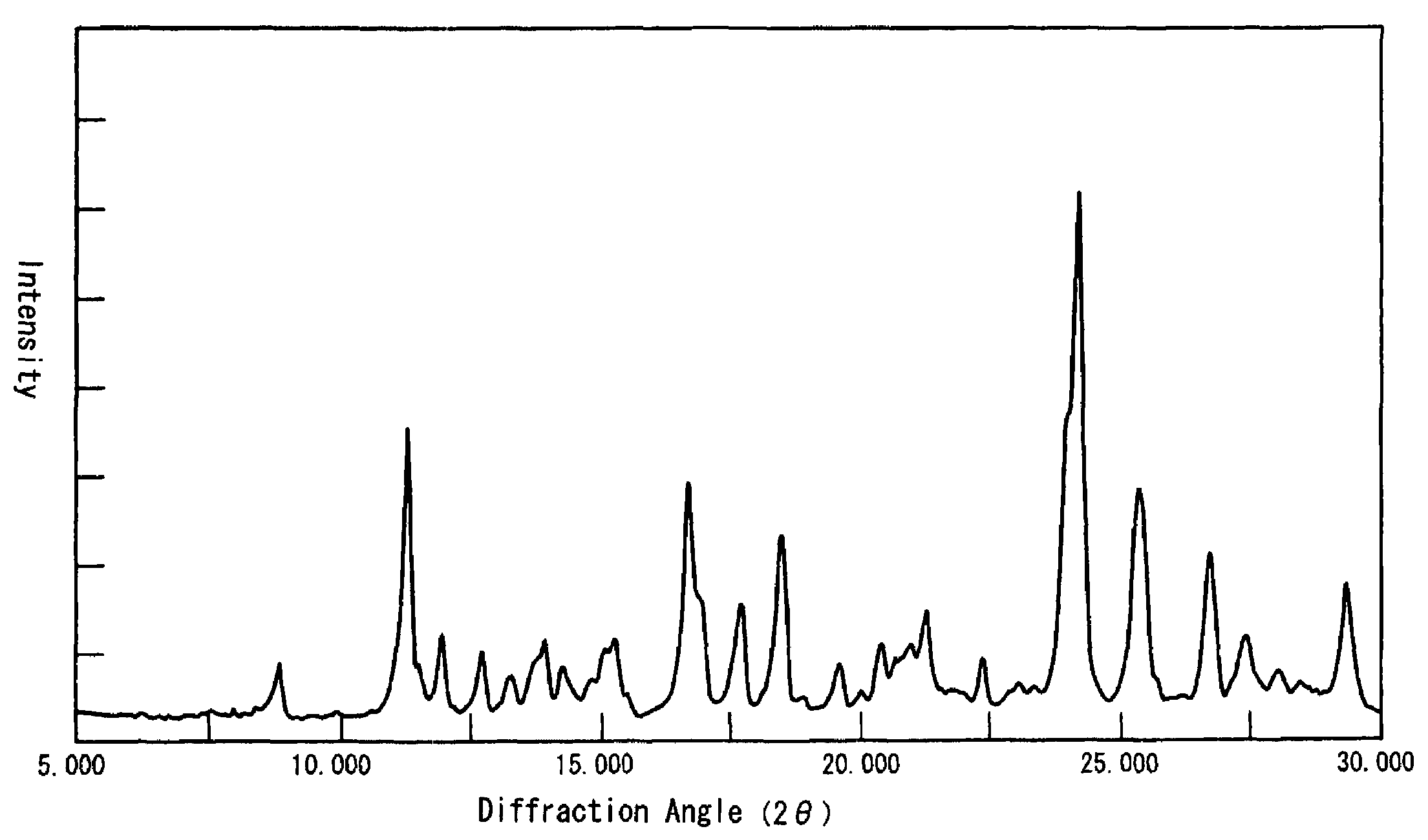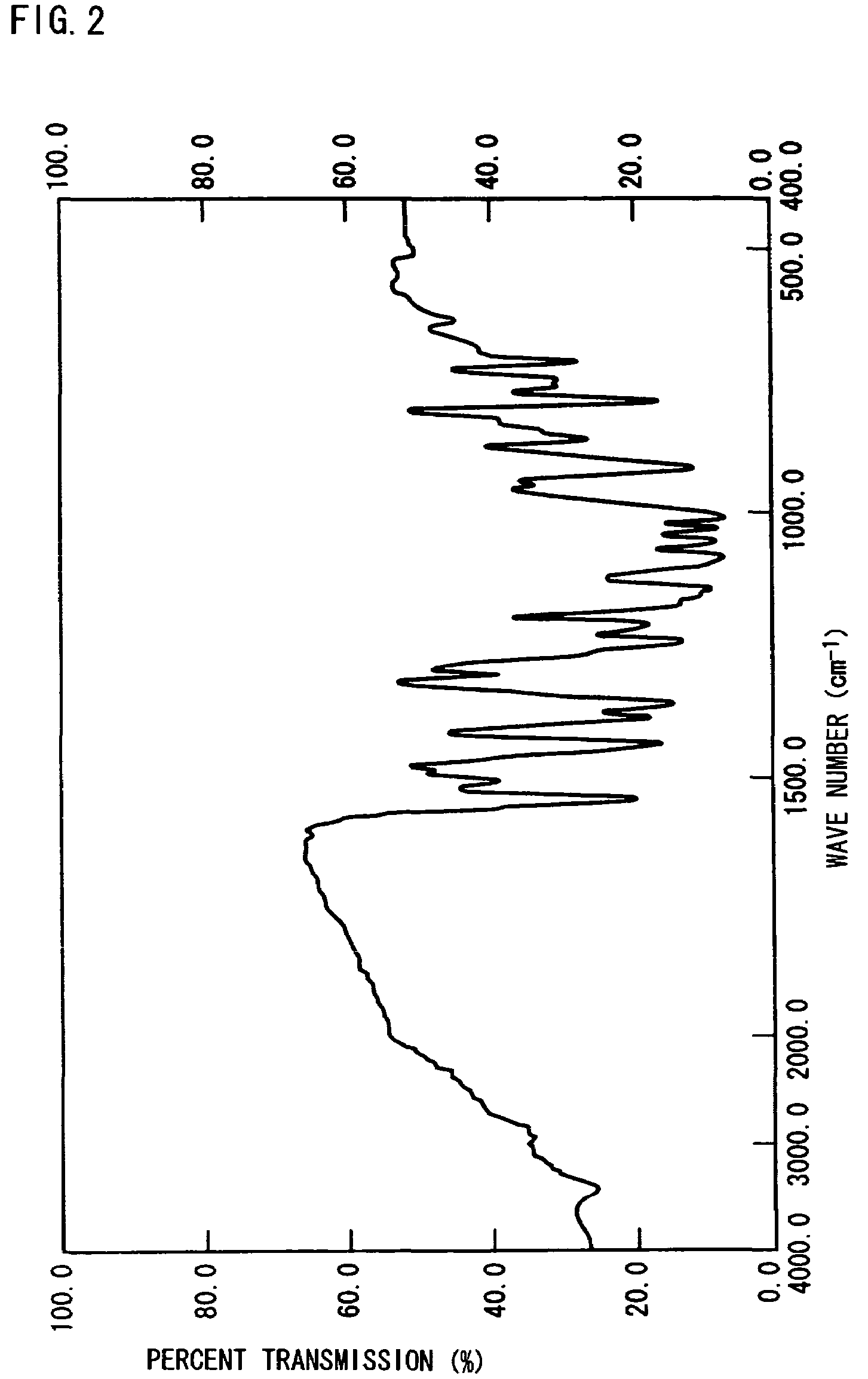Nonsolvate-form crystal of polymethine compound and process for producing the same
a non-solvate-form crystal and compound technology, applied in the field of new non-solvate-form crystals of polymethine compounds, can solve the problems of unknowable polymethine compounds capable of satisfying such requirements, limited in kind of acidic residues zsup>/sup>, undesirable use of them as raw materials for commercial scale production, etc., to achieve high gram extinction coefficient, stable solution, and high purity
- Summary
- Abstract
- Description
- Claims
- Application Information
AI Technical Summary
Benefits of technology
Problems solved by technology
Method used
Image
Examples
example 1
Synthesis of a Nonsolvate-Form Crystal of Polymethine Compound (X=Cl)
[0080]To 150 ml of acetone was added 15.45 g of polymethine ether compound represented by the formula (II) (R=CH3), and 2.00 g of hydrogen chloride gas was blown into the mixture with stirring at 25-30° C. The resulting mixture was stirred at that temperature for 1 hour and then heated to the refluxing temperature, and 50 ml of ethyl acetate was added dropwise. After 1 hour of stirring at the same temperature, the mixture was cooled to 15-20° C. The resulting crystalline precipitate was collected by filtration, washed with ethyl acetate and then dried to give 14.65 g of a compound of formula (I) (X=Cl).
[0081]This crystalline compound showed a solubility of not lower than 25% in each of methanol and ethanol. The elemental analysis data, melting point (decomposition temperature), absorption maximum wavelength (λmax) and gram extinction coefficient (εg) of this crystalline compound were as follows.
[0082]
Elemental anal...
example 2
Synthesis of a Nonsolvate-Form Crystal of Polymethine Compound (X=Br)
[0086]To 150 ml of acetone was added 15.45 g of a polymethine ether compound represented by the formula (II) (R=CH3), and 5.60 g of 48% hydrobromic acid was added dropwise to the mixture with stirring at 25-30° C. The resulting mixture was stirred at that temperature for 1 hour and then heated to the refluxing temperature, and 50 ml of ethyl acetate was added dropwise. After 1 hour of stirring at the same temperature, the mixture was cooled to 15-20° C. The resulting crystalline precipitate was collected by filtration, washed with ethyl acetate and then dried to give 16.10 g of a compound of formula (I) (X=Br).
[0087]This crystalline compound showed a solubility of not lower than 25% in each of methanol and ethanol. The elemental analysis data, melting point (decomposition temperature), absorption maximum wavelength (λmax) and gram extinction coefficient (εg) of this crystalline compound were as follows.
[0088]
Elemen...
example 3
Manufacture of a Near-Infrared Absorbing Material
[0092]A solution was prepared by dissolving 10 g of Delpet 80N (product of Asahi Chemical Industry; an acrylic resin) as a binder and 0.2 g of the crystalline compound of formula (I) (X=Cl) of the invention in 90 g of a mixed solvent composed of toluene / methyl ethyl ketone / methanol (1 / 1 / 0.1). This solution was applied, using a wire bar, to a polyethylene terephthalate (PET) film with an average thickness of 5 μm to a coat layer thickness, after drying, of about 5 μm. A near-infrared absorbing material specimen was thus obtained.
[0093]Laser beams emitted from a single-mode semiconductor laser (wavelength 830 nm) were condensed by means of a lens, and positions on the surface of the above specimen so that the beam diameter might amount to 10 μm. The semiconductor laser was adjusted so that the power of the laser beam arriving at the surface might be varied within the range of 50-200 mW, and the specimen was subjected to single pulse irr...
PUM
| Property | Measurement | Unit |
|---|---|---|
| TG | aaaaa | aaaaa |
| 2θ±0 | aaaaa | aaaaa |
| 2θ±0 | aaaaa | aaaaa |
Abstract
Description
Claims
Application Information
 Login to View More
Login to View More - R&D
- Intellectual Property
- Life Sciences
- Materials
- Tech Scout
- Unparalleled Data Quality
- Higher Quality Content
- 60% Fewer Hallucinations
Browse by: Latest US Patents, China's latest patents, Technical Efficacy Thesaurus, Application Domain, Technology Topic, Popular Technical Reports.
© 2025 PatSnap. All rights reserved.Legal|Privacy policy|Modern Slavery Act Transparency Statement|Sitemap|About US| Contact US: help@patsnap.com



